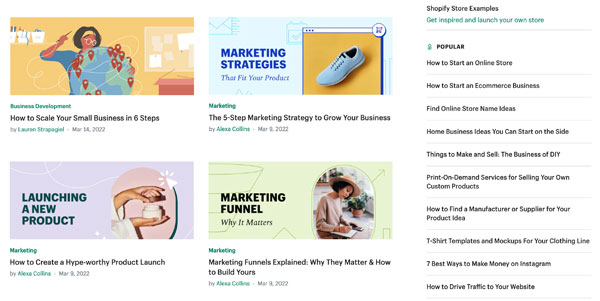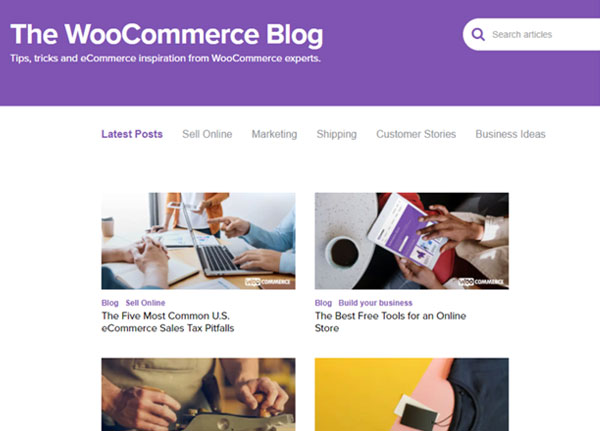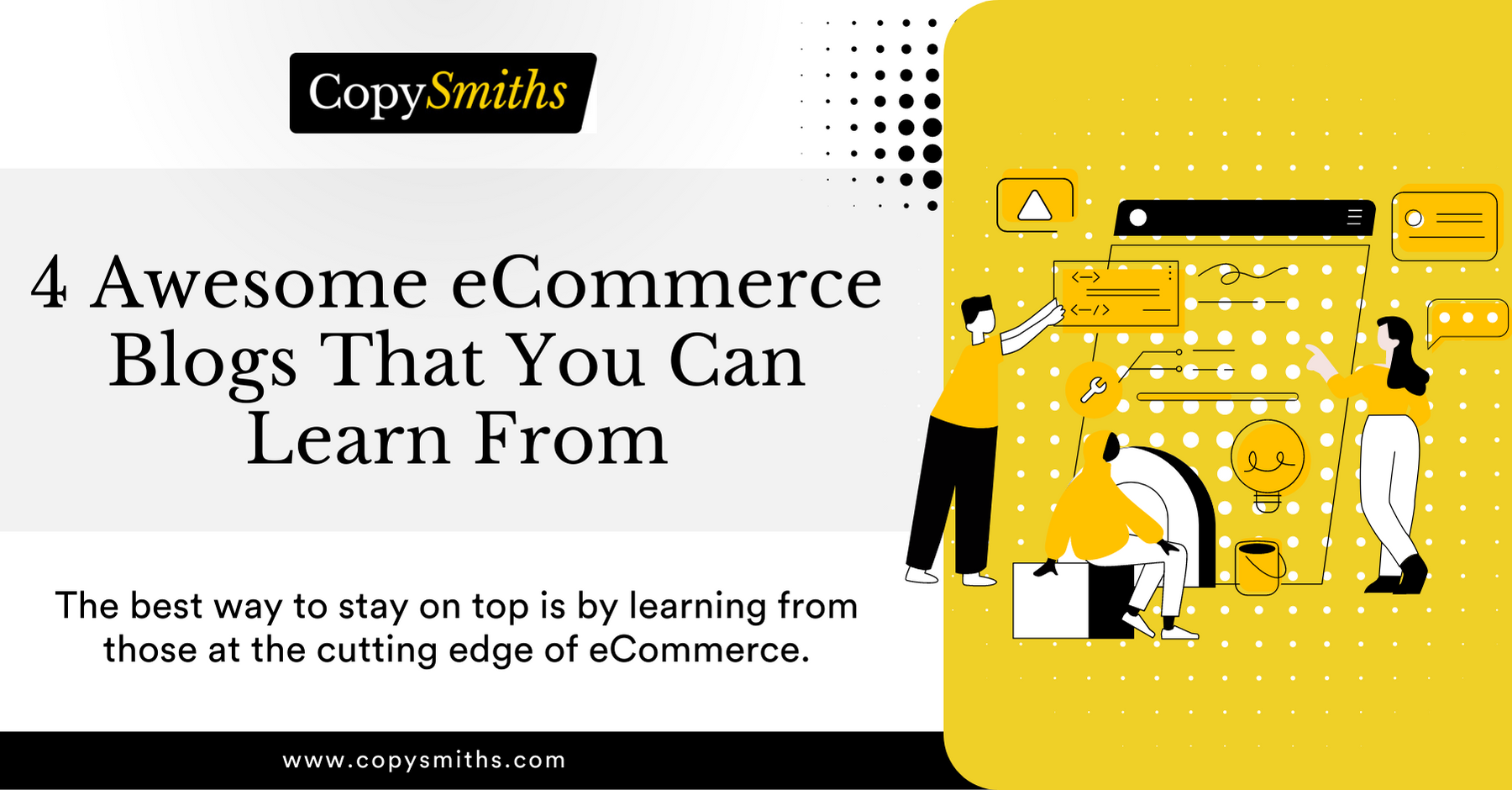Being a thought leader can help you build brand, trust, and credibility with your customers in the eCommerce realm.
Blogging is one of the best ways to establish your eCommerce brand as an expert in its field. Through it, you can communicate with your customers by providing content that teaches and informs them.
The eCommerce industry is ever-changing and competitive yet lucrative. To have an edge, you need to be at the top of your game.
The best way to stay ahead is by learning from those at the cutting edge of eCommerce.
Fortunately, many excellent bloggers in the eCommerce space share helpful experiences, case studies, and advice that every aspiring or experienced entrepreneur can benefit from.
Today, we present four awesome eCommerce blogs from which you can learn a lot. We look at:
- Great Jones
- Shopify
- Between the Sheets
- WooCommerce
Let’s find out more below:
1: Great Jones

Source: Great Jones
The Great Jones blog is named in honor of Judith Jones, an author and editor of an inspirational cookbook. The blog gathers some of the best recipes from around the web. It also shares news from the food world and gives inspiration for your kitchen.
What Makes Great Jones Awesome?
Several factors make the Great Jones blog awesome, and one you can learn a lot from as an eCommerce store owner.
- Excellent navigation. This places the blog higher on search engines. An easy-to-use navigation system is crucial for a successful eCommerce blog.It allows you to increase the time visitors spend on your site, meaning they can explore more information about your brand.
- Powerful, relevant stories. Great Jones features stories of top chefs and where they get information on why and how they cook.As each chef prepares a meal of their choice, Great Jones interviews them about their story and personality. After that, an article with photos detailing the whole experience is written in the first person.
The blog also features powerful recipes designed by various chefs and their inspiration.
Storytelling allows Great Jones to create unique and original content for the readers. It gives its audience valuable informational resources about different cultures through various recipes.
Key Take-Aways
What can you learn from the Great Jones blog?
Storytelling and interviews with industry experts can help you create unique content that stands out from your competitors. Below are more benefits of using stories in your content:
- They increase readers’ engagement.
- Readers will easily remember your brand through stories.
- They increase social shares.
When using the art of storytelling in your blog, ensure the story is:
- Educational
- Relevant
- Entertaining
- Memorable
Learn the four powerful storytelling formulas to create content that sells in the video below:
2: The Shopify eCommerce Marketing Blog

Source: Shopify eCommerce Marketing Blog
Shopify is a top-rated eCommerce blog that helps you sell online and offers the right tools to build your online store effortlessly.
Here’s a look at Shopify’s statistics to help you understand the success of the company.
| Specific Statistic | Value |
| Daily users | 2.1 million |
| Active stores | 1.75 million |
| Market share | 11 percent |
| Global economic activity contribution | $319 billion |
What Shopify Does Best
Shopify’s eCommerce blog has excellent information on marketing and running an eCommerce store. It offers excellent tips on optimizing your store and increasing sales.
Following the Shopify blog helps you understand how to:
- Drive traffic
- Increase conversion rates
- Market your brand effectively
- Build customer loyalty
Shopify also offers information such as:
- Profitable business ideas
- How to grow an eCommerce business
- Financial advice on increasing your store’s profitability
- Strategies on new client acquisition
Key Take-Aways
You can apply what Shopify is doing by making your blog a learning center. Adapt the following on your blog by using Shopify examples:
- Ensure your blog is easy to navigate. If you want your blog to be a learning center, ensure it’s easy for your readers to find what they’re looking for. That means having an intuitive navigation system and labeling things clearly.
- Provide your readers with valuable resources. If you’re writing about programming, include links to resources such as books and websites that can help them learn more about the topic.You can also include links to other blogs that discuss similar ideas to help your readers find additional information.
Create content specifically for learning purposes. Ensure your content offers educational value to your readers. Tutorials and how-to posts are excellent examples.
3: Between the Sheets Blog

Source: Between the Sheets
Between the Sheets is a blog run by Au Lit Fine Linens, a family-owned company that sells linens founded in 1981.
The blog is all about getting what you need out of your sheets, including:
- Why you should use them
- How to care for them
- Finding the right ones for you
Why Between the Sheets Is a Success
The success of the Between the Sheets blog can be attributed to the following:
- SEO-friendly content. The content on this blog follows the SEO strategies required to rank on Google.
- Product links. Between the Sheets offers a solution by providing links to recommended products without promoting them.
- Tips and advice. The blog has a Tips and Advice section that provides information to help readers make informed purchasing decisions.
Key Take-Aways
Like the Between the Sheets blog, you too can optimize your content for search engine optimization to achieve more outstanding results.
How do you optimize your content for SEO? Here are a few tips:
- Ensure your content aligns with your audience’s search intent.
- Ensure the main keywords are in the title and URL.
- Provide alt texts for your images.
- Use subheadings.
- Make your site mobile-friendly to provide an excellent user experience.
- Link to reputable sites in your industry.
4: The WooCommerce Blog

Source: The WooCommerce Blog
The WooCommerce blog is a resource for eCommerce news, insights, and stories about selling online. It covers news, data, statistics, and trends in eCommerce.
Why the WooCommerce Blog Is Worth Learning From
The WooCommerce team has done an incredible job with their blog. They’ve enjoyed huge success thanks to:
- Valuable tips. They provide valuable advice and best practices for sellers looking to grow their business.
- Various article formats. The blog has various content formats, including listicles, contrasts, podcasts, and articles. There’s always something for everyone.
- Powerful strategies. They offer powerful strategies to guarantee successful product delivery, giving customers an exceptional shopping experience.
Key Take-Aways
The WooCommerce blog uses different forms of content to educate its readers on various topics. You can also diversify your content type using these expert tips:
- Don’t repeat content. If you modify or repeat content, your audience will move to other sites.
- Build your customers’ trust with original content, infographics, and images. Offer well-researched and valuable content with relevant statistics.
- Diversify your topics and keywords using long-form content. Diversification helps your website rank for more than one keyword. That way, visitors can find you using different keywords.
Over to You
As an eCommerce store owner, you understand how crucial blogging is to the success of your business. That’s why you want your blog to stand out from the rest and drive traffic to your store.
To achieve that, you need stellar content to engage your audience and make them your customers.
That’s where CopySmiths comes in. We create top-notch blog content that’s well-researched and packed with creative ideas to attract massive traffic within a short period.
Here’s what Sander, one of our customers, had to say about us:
“It has been a pleasure working with the CopySmiths team – they are reliable, efficient, and great at curating high-quality content on complex subjects…”
— Sander Tamm, e-student.org.
Contact us today and let’s begin the journey to making your eCommerce blog awesome.
Frequently Asked Questions
What are the two main types of eCommerce?
The two main types of eCommerce are B2B and B2C. In B2B, a company sells its products or services to another company, while in B2C, it sells its products directly to the consumer.
Should my eCommerce store have a blog?
Yes. Even though it isn’t a requirement, blogging can lead to significant sales and profits.
How much does it cost to start an eCommerce website?
According to eDesk, the total cost of starting an eCommerce website ranges between $50 and $3000 per month, including the setup fee.
Share on LinkedIn

